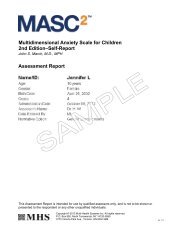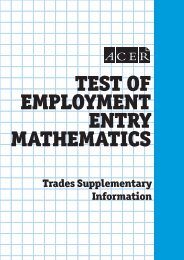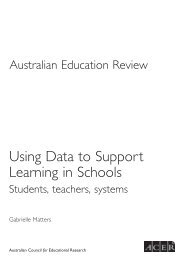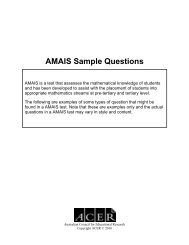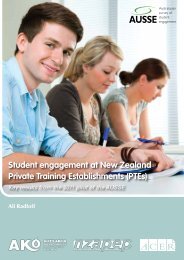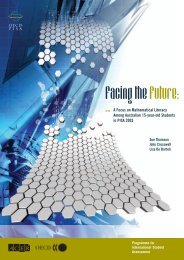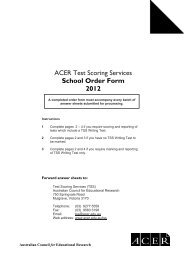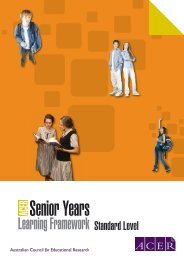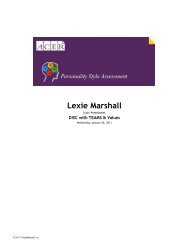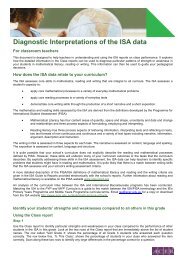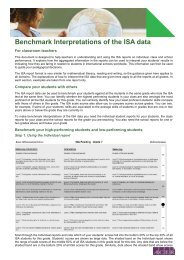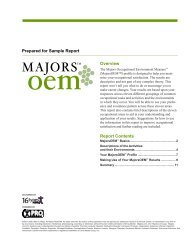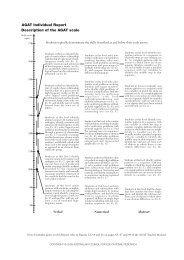National School Improvement Tool - ACER
National School Improvement Tool - ACER
National School Improvement Tool - ACER
Create successful ePaper yourself
Turn your PDF publications into a flip-book with our unique Google optimized e-Paper software.
6<br />
Systematic<br />
curriculum<br />
delivery<br />
The school has a coherent, sequenced plan for curriculum delivery that ensures<br />
consistent teaching and learning expectations and a clear reference for monitoring<br />
learning across the year levels. The plan, within which evidence-based teaching<br />
practices are embedded, and to which assessment and reporting procedures are<br />
aligned, has been developed with reference to the Australian Curriculum or other<br />
approved curriculum and refined collaboratively to provide a shared vision for<br />
curriculum practice. This plan is shared with parents and families.<br />
The assessment of this domain includes<br />
consideration of the extent to which:<br />
•§<br />
the school has an explicit, coherent,<br />
sequenced plan for curriculum delivery<br />
across the years of school which makes<br />
clear what (and when) teachers should<br />
teach and students should learn;<br />
•§<br />
the plan for curriculum delivery is shared<br />
with parents, families and the wider<br />
community and feedback is sought on<br />
ways to make the school curriculum<br />
responsive to local needs;<br />
•§<br />
staff of the school are familiar with<br />
and work within the school’s shared<br />
curriculum expectations;<br />
•§<br />
the curriculum is used as a basis for ongoing<br />
staff discussions about the best ways to<br />
maximise student learning and wellbeing;<br />
•§<br />
school leaders focus attention and energy<br />
on priority curriculum areas and on<br />
ensuring that all students are proficient<br />
in the basics, as well as on the appropriate<br />
key learning areas in Years 10-12;<br />
•§<br />
the school curriculum includes a strong<br />
focus on the development of crosscurricular<br />
skills and attributes such as<br />
literacy, numeracy, information and<br />
communication technology capability,<br />
critical and creative thinking, personal and<br />
social capability, ethical behaviour and<br />
intercultural understanding.;<br />
•§<br />
a priority is given to constructing learning<br />
experiences that are accessible, engaging<br />
and challenging for all students, including<br />
those with particular needs;<br />
•§<br />
the school places a priority on making the<br />
curriculum locally relevant and adopts a<br />
strengths-based approach to recognising,<br />
valuing and building on students’ existing<br />
knowledge and skills;<br />
•§<br />
assessment processes are aligned with the<br />
curriculum and are designed to clarify<br />
learning intentions, establish where<br />
individual students are in their learning,<br />
diagnose details of student learning (eg,<br />
gaps in knowledge and understanding),<br />
and to monitor learning progress across<br />
the years of school;<br />
•§<br />
reporting processes are aligned with the<br />
curriculum and designed to provide<br />
parents, families and students themselves<br />
with information about the achievement<br />
of curriculum intentions and progress<br />
over time; and<br />
•§<br />
professional development is provided to<br />
build staff skills in curriculum planning<br />
and development.<br />
12



